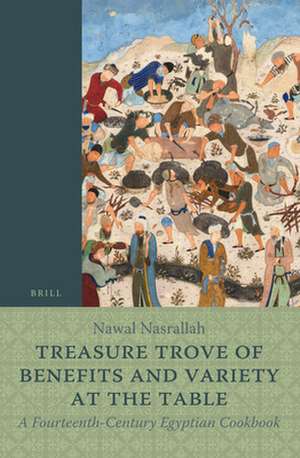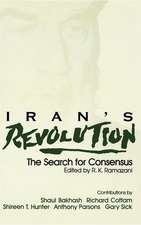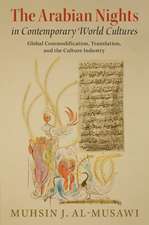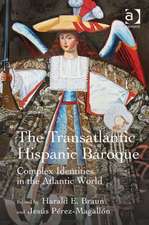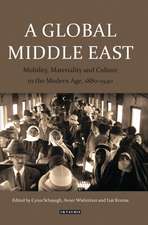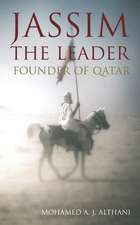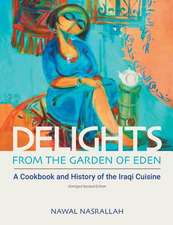Treasure Trove of Benefits and Variety at the Table: A Fourteenth-Century Egyptian Cookbook: English Translation, with an Introduction and Glossary
Autor Nawal Nasrallahen Limba Engleză Paperback – 12 feb 2020
It is the only surviving cookbook from a period when Cairo was a flourishing metropolis and a cultural haven for people of diverse ethnicities and nationalities. Now available for the first time in English, it has been meticulously translated and supplemented with a comprehensive introduction, glossary, and 117 color illustrations to initiate readers into the world of the Kanz al-fawāʾid. The twenty-two modern adaptations of Kanz recipes will inspire further experimentations. It is a valuable resource for scholars of medieval material culture, and for all lovers of good food and cookbooks.
Preț: 477.34 lei
Nou
Puncte Express: 716
Preț estimativ în valută:
91.37€ • 99.28$ • 76.80£
91.37€ • 99.28$ • 76.80£
Carte disponibilă
Livrare economică 31 martie-14 aprilie
Preluare comenzi: 021 569.72.76
Specificații
ISBN-13: 9789004356238
ISBN-10: 9004356231
Dimensiuni: 155 x 235 mm
Greutate: 0.95 kg
Editura: Brill
Colecția Brill
ISBN-10: 9004356231
Dimensiuni: 155 x 235 mm
Greutate: 0.95 kg
Editura: Brill
Colecția Brill
Recenzii
Winner of the Sheikh Hamad Award for Translation and International Understanding (1st Prize, Translation from Arabic into English.) click here.
Shortlisted for the Gourmand World Cookbook Awards 2018 in the categories Translation and Culinary History click here.
"A formidable intertwined offering from a historian, translator, cook, cooking instructor and writer... Nasrallah succeeds in giving a clear, simple and practical text in English to many of the 830 recipes which are difficult to understand and use, even for an Arabic speaker with culinary experience... After the full translated text, Nasrallah adds a helpful alphabetical glossary with an explanation of terms, methods and general commentaries, translations and correlations with dishes known today. Nasrallah ends her book with a fantastic contribution of 22 modern adaptations of some recipes from Kanz. All recipes were tried and photographed by the author. They are well written, easy to follow, and the outcome, as tested by this author, is delicious." - Hala N. Barakat, in: Madamasr (August 25, 2018) click here.
"For culinary enthusiasts as well as for those fascinated by Egypt’s heritage, the very first English-language translation of a mediaeval Egyptian cookbook entitled Treasure Trove of Benefits and Variety at the Table. A Fourteenth Century Egyptian Cookbook will come as a thrilling revelation." - Aziza Sami, in: Al-Ahram Weekly (August 31, 2018) click here.
"Nasrallah provides her readers not only with an annotated translation, but also details of texts and manuscripts, and excellent and detailed glossaries, helpfully divided into classes of food such as vegetables and legumes, fruits and nuts and so forth, as well as kitchen and cooking implements and culinary terms." Susan Weingarten, in: Mediterranean Historical Review, 33:2 (2018)
"The tremendous linguistic and contextual expertise that has gone into the preparation of this book has paid off. It is not only an invaluable historical document for the better understanding of the material culture and foodways of pre-modern Egyptian society, but also a fine example of thorough research and scholarly responsibility to one's material." - Leyla Rouhi, in: Al-Masāq, 30/3 (2018)
"Cet ouvrage contient tout ce que l’on peut attendre de la traduction d’un livre de cuisine médiéval : une traduction sérieuse (...), une présentation qui permette au lecteur, même non spécialiste, d’apprécier l’originalité du texte, des glossaires efficaces et une petite touche de gourmandise." - Audrey Caire, in: Arabica 65 (2018)
"N. Nasrallah nous propose ici un travail exceptionnel. Sa minutie et son expérience passée de la traduction d’ouvrages culinaires confère à ce livre une valeur scientifique indéniable, mais aussi une dimension sociale, vivante de ce que fut la cuisine arabe médiévale. Cette oeuvre réjouira tout autant le chercheur en quête d’informations que l’amateur curieux de mettre en pratique une cuisine riche, variée et colorée, nous rappelant que, contrairement à la cuisine occidentale, la cuisine arabe sut conserver les goûts, les produits et les modes de cuisson médiévaux et que l’on peut toujours, à une table de Tunis, du Caire ou de Damas, se faire une idée assez précise des plaisirs culinaires qu’éprouvaient les mangeurs pour qui l’auteur du Kanz rédigea son livre." - Veronique Pitchon, in: BCAI 33 (2019)
Read an interview about the book with the author on Marcia Lynx Qualey's blog ArabLit: click here.
Shortlisted for the Gourmand World Cookbook Awards 2018 in the categories Translation and Culinary History click here.
"A formidable intertwined offering from a historian, translator, cook, cooking instructor and writer... Nasrallah succeeds in giving a clear, simple and practical text in English to many of the 830 recipes which are difficult to understand and use, even for an Arabic speaker with culinary experience... After the full translated text, Nasrallah adds a helpful alphabetical glossary with an explanation of terms, methods and general commentaries, translations and correlations with dishes known today. Nasrallah ends her book with a fantastic contribution of 22 modern adaptations of some recipes from Kanz. All recipes were tried and photographed by the author. They are well written, easy to follow, and the outcome, as tested by this author, is delicious." - Hala N. Barakat, in: Madamasr (August 25, 2018) click here.
"For culinary enthusiasts as well as for those fascinated by Egypt’s heritage, the very first English-language translation of a mediaeval Egyptian cookbook entitled Treasure Trove of Benefits and Variety at the Table. A Fourteenth Century Egyptian Cookbook will come as a thrilling revelation." - Aziza Sami, in: Al-Ahram Weekly (August 31, 2018) click here.
"Nasrallah provides her readers not only with an annotated translation, but also details of texts and manuscripts, and excellent and detailed glossaries, helpfully divided into classes of food such as vegetables and legumes, fruits and nuts and so forth, as well as kitchen and cooking implements and culinary terms." Susan Weingarten, in: Mediterranean Historical Review, 33:2 (2018)
"The tremendous linguistic and contextual expertise that has gone into the preparation of this book has paid off. It is not only an invaluable historical document for the better understanding of the material culture and foodways of pre-modern Egyptian society, but also a fine example of thorough research and scholarly responsibility to one's material." - Leyla Rouhi, in: Al-Masāq, 30/3 (2018)
"Cet ouvrage contient tout ce que l’on peut attendre de la traduction d’un livre de cuisine médiéval : une traduction sérieuse (...), une présentation qui permette au lecteur, même non spécialiste, d’apprécier l’originalité du texte, des glossaires efficaces et une petite touche de gourmandise." - Audrey Caire, in: Arabica 65 (2018)
"N. Nasrallah nous propose ici un travail exceptionnel. Sa minutie et son expérience passée de la traduction d’ouvrages culinaires confère à ce livre une valeur scientifique indéniable, mais aussi une dimension sociale, vivante de ce que fut la cuisine arabe médiévale. Cette oeuvre réjouira tout autant le chercheur en quête d’informations que l’amateur curieux de mettre en pratique une cuisine riche, variée et colorée, nous rappelant que, contrairement à la cuisine occidentale, la cuisine arabe sut conserver les goûts, les produits et les modes de cuisson médiévaux et que l’on peut toujours, à une table de Tunis, du Caire ou de Damas, se faire une idée assez précise des plaisirs culinaires qu’éprouvaient les mangeurs pour qui l’auteur du Kanz rédigea son livre." - Veronique Pitchon, in: BCAI 33 (2019)
Read an interview about the book with the author on Marcia Lynx Qualey's blog ArabLit: click here.
Notă biografică
Nawal Nasrallah is an independent scholar, previously professor of English literature at the universities of Baghdad and Mosul. She has published books and articles on the history and culture of Arab food, including the Gourmand World Cookbook Award Winner of 2007 for best translated cookbook Annals of the Caliphs’ Kitchens (Brill, 2007), and Delights from the Garden of Eden (Equinox, 2013).
Cuprins
PREFACE
NOTES ON TRANSLATING THE TEXT
INTRODUCTION
PART I: THE MAKING OF KANZ AL-FAWĀʾID
1. The Text
2. The Provenance
3. Date and Sources
4. A Case of Abridged Borrowing: Kanz al-fawāʾid and Zahr al-ḥadīqa
PART II: MEDIEVAL EGYPTIAN FOOD CULTURE
5. Diet and Formation of a Cuisine
6. What was Cooking in Medieval Cairo?
7. The Culture of Food and Cooking
8. Shopping and Eating out
PART III
9. Medieval Egyptian Cooking as Reflected in Kanz al-fawāʾid
10. Eating in Good Health
INFINITE BENEFITS OF VARIETY AT THE TABLE (ENGLISH TRANSLATION)
Chapter 1: Indispensable Instructions for Cooks
Chapter 2: How to Knead Bread Dough and Bake It; and Making Varieties of Bread: Enhanced (muṭayyab), Seeded (mubazzar), Salted (mamlūḥ), and More
Chapter 3: Measures Taken When Drinking Water: muzammal, and Chilled with Ice (thalj maḍrūb)
Chapter 4: Qualities of Air-Cooled Water and What the Physicians Said About It
Chapter 5: Miscellany of Dishes
Chapter 6: Making murrī (Liquid Fermented Sauce), and Preserving Juice of Sour Unripe Grapes (māʾ al- ḥiṣrim) and Lemon Juice (māʾ al-laymūn)
Chapter 7: Eggs Cooked as Omelets and Other Dishes
Chapter 8: Vegetarian Dishes (muzawwarāt al-buqūl) for the Nourishment of the Sick
Chapter 9: All Kinds of Dishes Made with Different Varieties of Fish
Chapter 10: Making All Kinds of Sweets (ḥalwā)
Chapter 11: Digestive Stomachics (juwārishnāt), Electuaries (maʿājīn), and Drinks (ashriba) Offered Before and After the Meal
Chapter 12: Making fuqqāʿ (Foamy Beer), and Other Drinks
Chapter 13: Dried-Apricot Compote (naqūʿ al-mishmish)
Chapter 14: Making Preparations Which Relieve Nausea (adwiyat al-qaraf)
Chapter 15: Making Mustard [Condiments], Mild and Pungent-Hot
Chapter 16: Making Table Sauces (ṣulūṣāt)
Chapter 17: Dishes Made with Dairy (albān): kawāmikh (Fermented Condiments), jājaq (Drained-Yogurt Condiment), Condiments with kabar (Capers) and zaʿtar (Thyme); bīrāf (Clotted Cream); and the Like
Chapter 18: All Kinds of Pickled Turnip and Onion, Pickling Fruits and Vegetables of All Kinds, and Preserving Lemon, Damascus Citron and the Like, in Salt
Chapter 19: Making Cold Dishes (bawārid)
Chapter 20: On Aromatics (ṭīb), and Properties of Toothpicks (khilāl) Made from Willow Wood (ṣafṣāf) and Egyptian-Willow Twigs (ʿīdān al-khilāf)
Chapter 21: Varieties of Aroma-Diffusing Incense Which Fortify Spirit and Heart; Aromatizing Pills; Deodorants; and Other Preparations
Chapter 22: Top Quality Perfumed Powders (dharāʾir mulūkiyya) and Other Preparations
Chapter 23: Storing Fresh Fruits and Keeping Them to Use After Their Season
GLOSSARY
1. Beverages for Pleasure and Health
2. Breads, Grains, Pasta, Noodles, and Sweet and Savory Pastries
3. Dairy
4. Desserts, Sweeteners, and Conserves; for Pleasure and Health
5. Dishes and Prepared Foods: Main and Side Dishes, Snacks, Condiments, Pickles, Dips, and Table Sauces
6. Fats and Oils
7. Fruits and Nuts
8. Ingredients Used in Foods and Medicinal Preparations: Herbs, Spices, Aromatics, Minerals, Food Colors, and Seasoning Sauces
9. Kitchen and Cooking Implements, and Culinary Techniques and Terms
10. Meat
11. Medical Terms, Medicinal Preparations, and Personal Hygiene and Perfumes
12. Vegetables and Legumes
13. Weights and Measures
APPENDIX: A TASTE OF TIME: MODERN ADAPTATIONS OF TWENTY-TWO RECIPES FROM THE KANZ AL-FAWĀʾID
WORKS CITED
INDICES
NOTES ON TRANSLATING THE TEXT
INTRODUCTION
PART I: THE MAKING OF KANZ AL-FAWĀʾID
1. The Text
2. The Provenance
3. Date and Sources
4. A Case of Abridged Borrowing: Kanz al-fawāʾid and Zahr al-ḥadīqa
PART II: MEDIEVAL EGYPTIAN FOOD CULTURE
5. Diet and Formation of a Cuisine
6. What was Cooking in Medieval Cairo?
7. The Culture of Food and Cooking
8. Shopping and Eating out
PART III
9. Medieval Egyptian Cooking as Reflected in Kanz al-fawāʾid
10. Eating in Good Health
INFINITE BENEFITS OF VARIETY AT THE TABLE (ENGLISH TRANSLATION)
Chapter 1: Indispensable Instructions for Cooks
Chapter 2: How to Knead Bread Dough and Bake It; and Making Varieties of Bread: Enhanced (muṭayyab), Seeded (mubazzar), Salted (mamlūḥ), and More
Chapter 3: Measures Taken When Drinking Water: muzammal, and Chilled with Ice (thalj maḍrūb)
Chapter 4: Qualities of Air-Cooled Water and What the Physicians Said About It
Chapter 5: Miscellany of Dishes
Chapter 6: Making murrī (Liquid Fermented Sauce), and Preserving Juice of Sour Unripe Grapes (māʾ al- ḥiṣrim) and Lemon Juice (māʾ al-laymūn)
Chapter 7: Eggs Cooked as Omelets and Other Dishes
Chapter 8: Vegetarian Dishes (muzawwarāt al-buqūl) for the Nourishment of the Sick
Chapter 9: All Kinds of Dishes Made with Different Varieties of Fish
Chapter 10: Making All Kinds of Sweets (ḥalwā)
Chapter 11: Digestive Stomachics (juwārishnāt), Electuaries (maʿājīn), and Drinks (ashriba) Offered Before and After the Meal
Chapter 12: Making fuqqāʿ (Foamy Beer), and Other Drinks
Chapter 13: Dried-Apricot Compote (naqūʿ al-mishmish)
Chapter 14: Making Preparations Which Relieve Nausea (adwiyat al-qaraf)
Chapter 15: Making Mustard [Condiments], Mild and Pungent-Hot
Chapter 16: Making Table Sauces (ṣulūṣāt)
Chapter 17: Dishes Made with Dairy (albān): kawāmikh (Fermented Condiments), jājaq (Drained-Yogurt Condiment), Condiments with kabar (Capers) and zaʿtar (Thyme); bīrāf (Clotted Cream); and the Like
Chapter 18: All Kinds of Pickled Turnip and Onion, Pickling Fruits and Vegetables of All Kinds, and Preserving Lemon, Damascus Citron and the Like, in Salt
Chapter 19: Making Cold Dishes (bawārid)
Chapter 20: On Aromatics (ṭīb), and Properties of Toothpicks (khilāl) Made from Willow Wood (ṣafṣāf) and Egyptian-Willow Twigs (ʿīdān al-khilāf)
Chapter 21: Varieties of Aroma-Diffusing Incense Which Fortify Spirit and Heart; Aromatizing Pills; Deodorants; and Other Preparations
Chapter 22: Top Quality Perfumed Powders (dharāʾir mulūkiyya) and Other Preparations
Chapter 23: Storing Fresh Fruits and Keeping Them to Use After Their Season
GLOSSARY
1. Beverages for Pleasure and Health
2. Breads, Grains, Pasta, Noodles, and Sweet and Savory Pastries
3. Dairy
4. Desserts, Sweeteners, and Conserves; for Pleasure and Health
5. Dishes and Prepared Foods: Main and Side Dishes, Snacks, Condiments, Pickles, Dips, and Table Sauces
6. Fats and Oils
7. Fruits and Nuts
8. Ingredients Used in Foods and Medicinal Preparations: Herbs, Spices, Aromatics, Minerals, Food Colors, and Seasoning Sauces
9. Kitchen and Cooking Implements, and Culinary Techniques and Terms
10. Meat
11. Medical Terms, Medicinal Preparations, and Personal Hygiene and Perfumes
12. Vegetables and Legumes
13. Weights and Measures
APPENDIX: A TASTE OF TIME: MODERN ADAPTATIONS OF TWENTY-TWO RECIPES FROM THE KANZ AL-FAWĀʾID
WORKS CITED
INDICES
